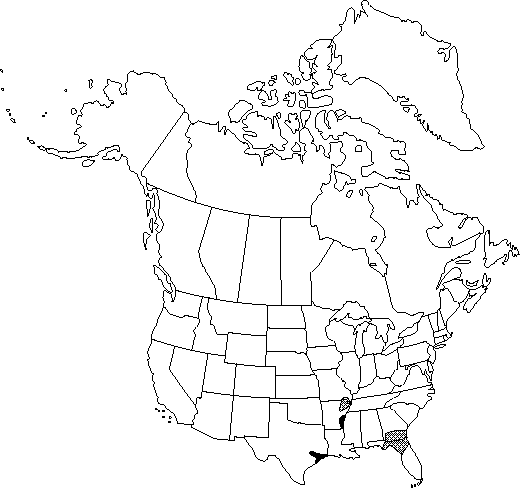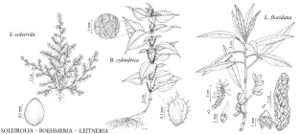Leitneria floridana
Fl. South. U.S., 427. 1860.
Shrubs or small trees, 1-4(-8) m, to 15 cm diam. at base. Stems unbranched or sparsely short-branched distally, slender, pubescent, becoming glabrous. Bark gray to dark reddish brown; lenticels numerous, gray. Leaves: petiole 2-7 cm, densely pubescent, becoming ± glabrous. Leaf blade lanceolate to elliptic-lanceolate, 5-20 × 3.5-6 cm, leathery, base acute, margins narrowly revolute, apex acute to acuminate; surfaces silky-pubescent when young, becoming glabrous and glossy adaxially. Inflorescences: staminate catkins cylindric in bud, lax and outward curving at anthesis, 2-6 × 1-1.5 cm; pistillate stiffly erect, 1-3 × 1 cm. Staminate flowers: stamens (3-)10-12(-15); filaments short; anthers basifixed, broadly oblong, 4-sporangiate, 2-locular at anthesis, dehiscing longitudinally. Pistillate flowers: sepals (3-)4(-8), irregularly inserted, unequal; ovary elliptic, ca. 2 mm, finely pubescent; style 4-5 mm; stigma exserted, often recurved or twisted, reddish. Drupes erect, green, becoming chestnut brown, elliptic to oblong-elliptic, often compressed on drying, 1-2.5 cm, glabrous, base and apex blunt, apex with conspicuous dark stylar scar, vascular bundles toughening the thin flesh; endocarp brown, bony, surface rough-reticulate. Seeds 1, compressed; seed coat membranous, hilum blackish, elongate; endosperm thin, starchy; embryo large, straight; cotyledons ovoid, slightly fleshy. 2n = 32.
Phenology: Flowering late winter–early spring; fruiting spring–summer.
Habitat: Open or forested swamps, wet thickets, roadside ditches, saw-grass-palmetto marshes, estuarine tidal shores
Elevation: 0-100 m
Distribution

Ark., Fla., Ga., Mo., Tex.
Discussion
Of conservation concern.
Vegetative reproduction is predominant, forming large clones from adventitious buds on shallow roots. Large, old plants ("small trees") are apparently rare in the field. Florida plants begin growth about a month before Missouri plants (J. W. Day 1975). Leitneria floridana is successfully cultivated as far north as Chicago, Rochester, and Boston.
The wood (sp. gr. 0.21) is lighter than cork (sp. gr. 0.24); it is used locally for fishnet floats or bottle stoppers.
Selected References
None.
